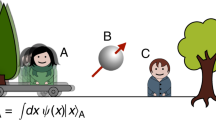Abstract
The extension of the principle of relativity to general coordinate systems is based on the hypothesis that an accelerated observer is locally equivalent to a hypothetical inertial observer with the same velocity as the noninertial observer. This hypothesis of locality is expected to be valid for classical particle phenomena as well as for classical wave phenomena but only in the short-wavelength approximation. The generally covariant theory is therefore expected to be in conflict with the quantum theory which is based on wave-particle duality. This is explicitly demonstrated for the frequency of electromagnetic radiation measured by a uniformly rotating observer. The standard Doppler formula is shown to be valid only in the geometric optics approximation. A new definition for the frequency is proposed, and the resulting formula for the frequency measured by the rotating observer is shown to be consistent with expectations based on the classical theory of electrons. A tentative quantum theory is developed on the basis of the generalization of the Bohr frequency condition to include accelerated observers. The description of the causal sequence of events is assumed to be independent of the motion of the observer. Furthermore, the quantum hypothesis is supposed to be valid for all observers. The implications of this theory are critically examined. The new formula for frequency, which is still based on the hypothesis of locality, leads to the observation of negative energy quanta by the rotating observer and is therefore in conflict with the quantum theory.
Similar content being viewed by others
References
E. Wigner, inJubilee of Relativity Theory (Bern, 1955),Helv. Phys. Acta, Suppl. IV (Birkhäuser Verlag, Basel, 1956), pp. 210–226.
E. Kretschmann,Ann. Phys. (Leipzig) 53, 575 (1917).
A. Einstein,Ann. Phys. (Leipzig) 17, 891 (1905).
H. A. Lorentz,The Theory of Electrons (2nd edn., 1915) (Dover, New York, 1952).
E. T. Whittaker,A History of the Theories of Aether and Electricity (Nelson, London, 1951), Vol. 1, Chap. XIII.
L. D. Landau and E. M. Lifshitz,Mechanics (Pergamon Press, Oxford, 1960), Chap. VI.
I. I. Rabi, N. F. Ramsey, and J. Schwinger,Rev. Mod. Phys. 26, 167 (1954).
J. M. Weisberg and J. H. Taylor,Phys. Rev. Lett. 52, 1348 (1984).
B. Mashhoon,Nature (London) 250, 316 (1974).
B. Mashhoon,Phys. Rev. D 11, 2679 (1975).
Author information
Authors and Affiliations
Rights and permissions
About this article
Cite this article
Mashhoon, B. General covariance and quantum theory. Found Phys 16, 619–635 (1986). https://doi.org/10.1007/BF01889625
Received:
Issue Date:
DOI: https://doi.org/10.1007/BF01889625



